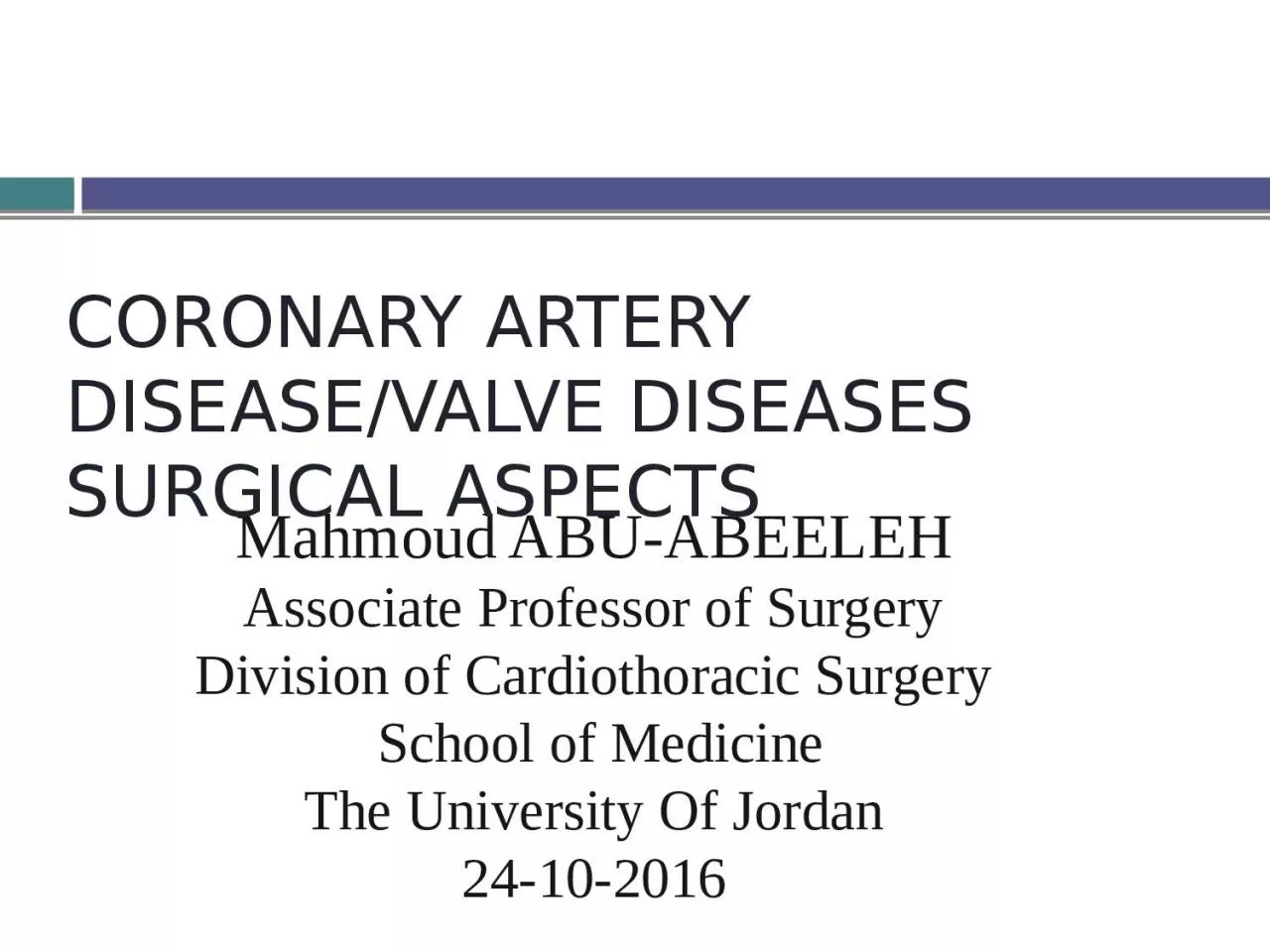

Professor of Surgery Division of Cardiothoracic Surgery School of Medicine The University Of Jordan 24102016 CORONARY ARTERY DISEASEVALVE DISEASES SURGICAL ASPECTS HISTORY OF CARDIAC SURGERY ID: 926727
Download Presentation The PPT/PDF document "Mahmoud ABU-ABEELEH Associate" is the property of its rightful owner. Permission is granted to download and print the materials on this web site for personal, non-commercial use only, and to display it on your personal computer provided you do not modify the materials and that you retain all copyright notices contained in the materials. By downloading content from our website, you accept the terms of this agreement.
Slide1
Mahmoud ABU-ABEELEHAssociate Professor of SurgeryDivision of Cardiothoracic Surgery School of MedicineThe University Of Jordan24-10-2016
CORONARY ARTERY DISEASE/VALVE DISEASES SURGICAL ASPECTS
Slide2HISTORY OF CARDIAC SURGERYCORONARY ARTERY ANATOMYATHEROSCLEROSIS CADDIAGNOSIS MANAGEMENTVALVE DISEASESSURGICAL INDICATIONS /TECHNIQUESINTRODUCTION
Slide3Adult Cardiac Surgery: Ischemic Heart Disease (History)Arthur Vineberg1940’s- Mobilization of left internal mammary artery with implantation of bleeding end into the left ventricle.1964- follow-up study on 140 patients 33% mortality 85% relief from angina
Slide4Slide5Adult Cardiac Surgery: Ischemic Heart Disease (History) Mason Sones, 1962- direct and reproducible catheterization of the coronary arteries. “Collectively, all of the cardiological advances in this century pale in comparison with this priceless achievement.” Floyd Loop, MD
Slide6Adult Cardiac Surgery: Ischemic Heart Disease (History)“During the long night, helplessly watching the patient struggle for life as her blood became darker and her veins more distended, the idea naturally occurred to me that if it were possible to remove some of the blue blood…put oxygen into that blood and allow carbon dioxide to escape from it, and then to inject continuously the now-red blood back into the patient’s arteries, we might have saved her life.”Heart-lung machineMay 6, 1953- ASD closureJohn H. Gibbon, Jr.
Slide7Heart Lung Machine
Slide8Adult Cardiac Surgery: Ischemic Heart Disease (History)KOLOSOV LIMA -LAD 1964 IN RussiaFrank Spencer/George GreenInternal mammary artery
Slide9Coronary Artery Anatomy
Slide10Coronary Artery Anatomy
Slide11The Normal Heart - Coronary Artery Anatomy
Slide12Ischaemic Heart DiseaseIt results from imbalance between oxygen demand and supply
Slide13Canadian Cardiovascular SocietyClassificationI: No angina with ordinary physical activityII: Slight limitation of ordinary activityIII: Marked limitation of ordinary activityIV: Symptoms with any activity or at rest
Slide14AetiologyAtherosclerosis (>90%)EmbolisationCoronary spasmVasculitisOstial stenosisSevere LVHCongenital anomalies of the coronary artereis (e.g anomalous origin of LAD artery from pulmonary artery)
Slide15Slide16Pathogenesis of ACS
Slide17ATHEROSCLEROSIS
Slide1818Risk FactorsUncontrollable
Sex
Hereditary
Race
Age
Controllable
High blood pressure
High blood cholesterol
Smoking
Physical activity
Obesity
Diabetes
Stress and anger
Slide19CADDiagnosisHistoryPhysical examinationECG findingscardiac enzymes
Slide20InvestigationsECGCardiac enzymesChest x-rayFBSSerum lipidsTMTStress or pharmacologic stress myocardial perfusion studiesCardiac CT-ScanCoronary angiography
Slide21Treatment of CADNitratesBeta blockersAspirin/PLAVIX DUAL ANTIPLATELT THERAPYCa-channel blockers(in coronary spasm)Treating the associated risk factorsTreating the precipitating factorRevascularization ( if indicated) SURGICAL VS INTERVENTIONAL
Slide22COX (cyclo-oxygenase)ADP (adenosine diphosphate)TXA2 (thromboxane A2)CLOPIDOGRELASA
COX
ADP
ADP
C
GPllb/llla
(Fibrinogen receptor)
Collagen thrombin
TXA
2
Activation
TXA
2
ASA
Synergistic Mode of Action with Clopidogrel and ASA
1
Slide23Indications for open-heart surgeryCoronary Artery Bypass Grafting: (CABG)Triple vessel diseaseLf main coronary artery diseaseUnstable angina ,failed Mx therapyComplications of PTCALife threatening complications of MIAnomalies of Coronary arteries.
Slide24Adult Cardiac Surgery: CABG TechniquesMedian sternotomyCardiopulmonary bypass Cardioplegic arrestMammary artery, reversed saphenous vein, radial artery.
Slide25Slide26Slide27Heart Lung Machine
Slide28Slide29Slide30Slide31Slide32Arterial vs Venous conduits
Slide33Total arterial revascularization
Slide34Slide35PTCA
Slide36Slide37
Slide38Adult Cardiac Surgery: Valvular Heart DiseaseAortic stenosis- Age-related degenerative Mild AS: AVA > 1.5cm2 ; Moderate 1-1.5cm2 ; Severe <1cm2Indications for surgery largely based on symptomsSyncope, angina, dyspnea and CHFAortic regurgitation-Calcific aortic disease, idiopathic degenerative disease, endocarditis, rheumatic disease, bicuspid valve, aortic dissection, Marfan, etc.Indications for surgeryAcute AR- inadequate time for ventricular compensationChronic AR- symptoms, decreasing EF, LVEDD >75mm, LVESD >55mm
Slide39Adult Cardiac Surgery: Valve ProsthesesMechanical ValvesCaged-ball valvesTilting disc valvessingle leafletbileafletTissue ValvesAnimal tissue (porcine aortic valves, bovine pericardium)Human tissue (Homografts, Autografts)
Slide40Adult Cardiac Surgery
Slide41Adult Cardiac Surgery: Aortic Valve ReplacementMedian sternotomy, hemi-sternotomyCardiopulmonary bypassCardioplegic arrestExcision of the valveDebridementImplantation
Slide42Slide43Adult Cardiac Surgery : Valvular Heart DiseaseMitral Regurgitation-Myxomatous degeneration, ischemic, rheumatic valve disease, endocarditis, chordal rupture, dilated cardiomyopathy, etc.Surgical indicationsSymptomatic with 3+ to 4+ MR, asymptomatic with 3+ to 4+ MR and a decrease in EF, LV dilatation, new onset of atrial fibrillationMitral Stenosis-Rheumatic heart disease, annular/leaflet calcification, congenital deformities, endocarditis, etc.Surgical indicationsMVA ≤ 1.0cm2
Slide44Adult Cardiac Surgery : Mitral Valve SurgeryRepair more commonly performed than replacement.Replacement necessary in some casesRheumatic heart disease, endocarditis, complications of MI, etc.Median sternotomyMinimal access incisionsCardiopulmonary bypassCardioplegic arrest
Slide45Slide46Slide47Adult Cardiac Surgery: ACC/AHAAll patients with mechanical valves require warfarin therapy. Even with warfarin, risk of thromboembolism (TE) is 1-2%/yr.Risk of TE in patients with biological valves in NSR is 0.7%/yr.Risk of TE is greater with a valve in the mitral (mechanical or biological) than aortic position.
Slide48Adult Cardiac Surgery: ACC/AHA Task Force: 1998Aortic positionBileaflet- INR of 2-3Other disk valves and Starr-Edwards- INR 2.5-3.5In patients with higher risk of TE, INR 2.5-3.5 with addition of aspirin 80-100mg/d. (AF, ↓EF, prior TE, hypercoagulable state)Mitral positionAll- INR 2.5-3.5
Slide49Adult Cardiac Surgery: ACC/AHA Tissue prosthesis-Anticoagulation recommended in first 3 months, although aspirin alone in aortic position in some centers. INR 2.5-3.5After 3 months, discontinue unless other circumstances
Slide50Recovery for all patients after heart surgery Quitting smoking Treating high cholesterol Managing high blood pressure and diabetes Exercising regularly Maintaining a healthy weight Eating a heart-healthy diet Participating in a cardiac rehabilitation programFollowing up for regular clinic visits
Slide51Any Questions
Slide52SUMMARY